QT2 Drills - Documents and Videos
This is where you will find what QT2 considers to be the most important drills, aimed at some of the more basic skill elements of swimming, biking, and running.
Running Videos and Documents
Hill Bounding
See Hill Bounding - HERE
Purpose:
The purpose of Hill Bounding is to help the athlete develop running strength and technique. Hill Bounding creates an anabolic running environment, where the runner focuses on the development of their knee drive and push-off, as well as a forward leaning chest. While the purpose of this exercise is to work on strength and technique, the runner understands that this is a high-intensity running drill, and not a mechanically efficient means of climbing a hill.
Swim Drills/Cords - Videos and Documents
Sweet Spot
See Sweet Spot Drill - HERE
Purpose:
The purpose of Sweet Spot is to work on the swimmer’s body-alignment in the water. One of the biggest limiters amongst swimmers, particularly those who start later in life, is in-water balance.
Sweet Spot aims to teach the swimmer to develop in-water balance by “pressing their buoy”. The swimmer’s “buoy” represents their upper-torso. Pressing the upper-torso into the water is far more effective for body balance than burying the head under water.
Long Vessel Sweet Spot
See Long Vessel Sweet Spot Drill - HERE
Purpose:
The purpose of Long Vessel Sweet Spot is to work on the swimmer’s in-water body-alignment, while rolling from side to side, as during breathing.The purpose of this drill is to help the swimmer to develop the feel of "pressing their buoy" (chest, shoulder, upper-back), uniformly, as their body rolls to grab a breath.
Skate
See Skate Drill - HERE
Purpose:
The purpose of the Skate drill is to restore in-waterbalance to a swimmer’s stroke by engaging the core andthelegs. This drill helps swimmers to focus on rotational balance in the streamlined position.
Zipper Skate
See Zipper Skate Drill - HERE
Purpose:
The purpose of the Zipper Skate drill is to work on the swimmer’s in-water body position during the beginning portion of the stroke. This drill also reminds the swimmer of the importance of a high elbow. The Zipper Skate drill helps the swimmer to maintain a compact and tight torso, while decreasing drag and saving energy.
Single Zipper Switch
See Single Zipper Switch Drill - HERE
Purpose:
The purpose of the Single Zipper Switch drill is to work on the swimmer’s in-water body position during the stroke. This drill also reminds the swimmer of the importance of a high elbow during the stroke's recovery phase, and transition into the catch phase. This also helps the swimmer to maintain a compact and tight torso, while decreasing drag and saving energy. The Single Zipper Switch focuses on the body's in-water balance behavior for a single arm, half of the stroke cycle.
Double Zipper Switch
See Double Zipper Switch Drill - HERE
Purpose:
The purpose of the Double Zipper Switch drill is to work on the swimmer’s in-water body position during one full stroke-cycle. This drill also reminds the swimmer of the importance of a high elbow during the stroke's recovery phases, and transition into the catch phases. This also helps the swimmer to maintain a compact and tight torso, while decreasing drag and saving energy.
Triple Zipper Switch
See Triple Zipper Switch Drill - HERE
Purpose:
The purpose of the Triple Zipper Switch drill is to work on the swimmer’s in-water body position during one-and-a-half stroke-cycles. This drill also reminds the swimmer of the importance of a high elbow during the stroke's recovery phases, and transition into the catch phases. This also helps the swimmer to maintain a compact and tight torso, while decreasing drag and saving energy.
Swim GOLF
See Swim GOLF Drill - HERE
Purpose:
Thepurpose of the Swim GOLF drill is to help a swimmer increase their in-water distance per stroke. Theobjective is to swim50-yards as quickly as possible, with as few strokes as possible. The swimmer's GOLF score is the sum of their 50-yard time (in seconds), and the number of strokes they took to achieve it (each time a hand enters the water counting as a stroke). The goal of Swim GOLF is to achieve as low a score as possible.
Swim Cord (Front Half)
See Swim Cord (Front Half) - HERE
Purpose:
The Swim Cord (Front-Half) drill focuses on the front end ofaswimmer’s stroke by creating the basis for a strong catch phaseof the stroke.The goal of this drill is to maintain a high elbow as the swimmer transitions from the stroke's recovery phase into its catch phase.
Swim Cord (Back Half)
See Swim Cord (Back Half) - HERE
Purpose:
The purpose of the Swim Cord (Back-Half) is to work on swimmer's follow-through, during the pull phase of the stroke.This drill encourages the swimmer to finish their stroke beyond the hips.
Swim Cord Strength Routine
When learning the half pull, keep your movement slow and controlled with very light resistance. Then add speed to the half pull. Then add resistance to the half pull. Same for all the exercises. The long-term goal should be to train the muscles so you can bring the quickness of the catch into your swim stroke.
Strength routine should include two sets each of:
*Front Half Pull
*Back Half Push
*Standing Straight Arm
The 2 sets of each exercise should be as follows: 60 seconds on, 60 seconds off. Athletes MUST hold 100% perfect form at all times. Most important is to maintain a high elbow
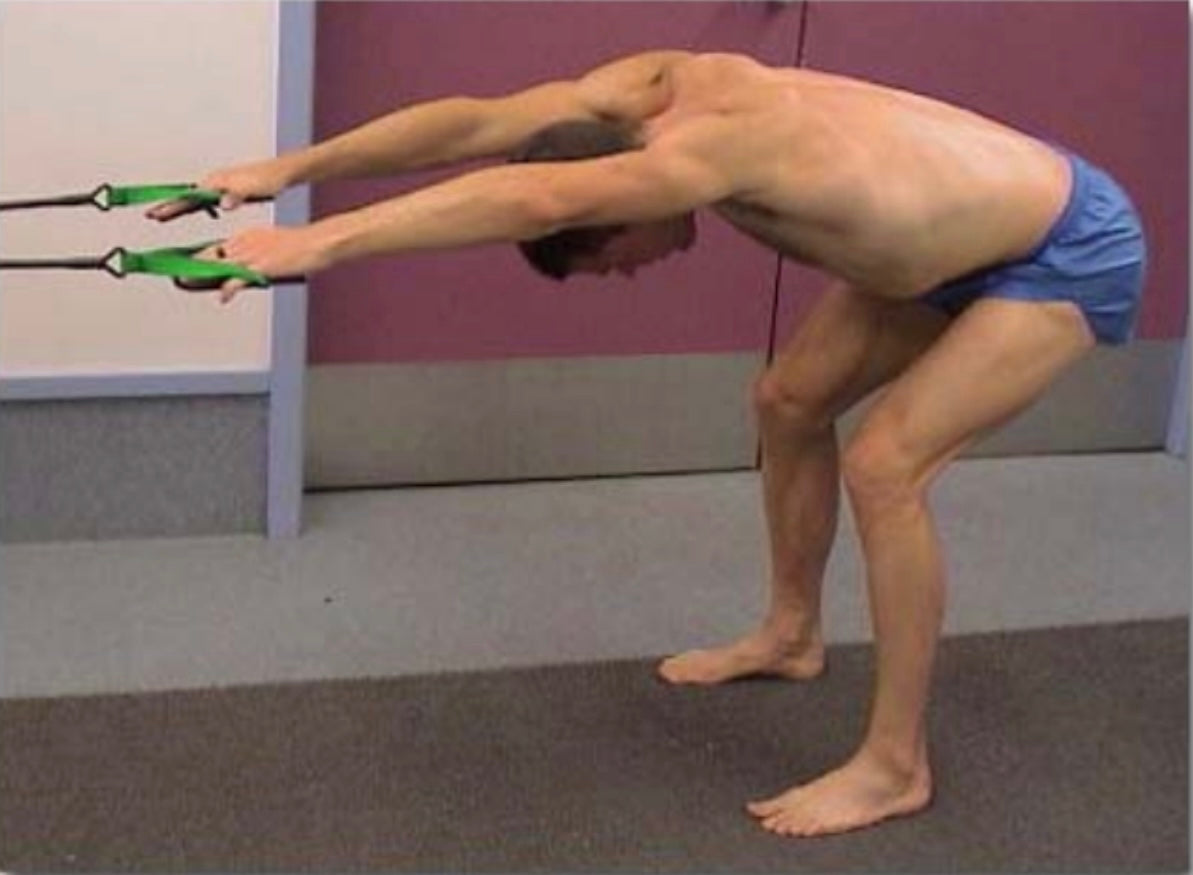
#1 - Front-Half Pulls
Set cords up as for full pulls. Arms extended until cords are 'just' tight. Elbow stays perfectly still while forearm rotates forward and down. Elbow stays high and still, hand remains aligned with forearm, arm/forearm/hand all rotate slightly outwards. Elbow does not move back. All movement is done with forearms. Goal is to build very front-end strength.
Head position is a bit low. Look down and slightly forward.

Step One:
Starting Position -- shoulders are high relative to hips, perhaps a higher tie point. Goal should be aligment of hip/shoulder/wrist at the start.
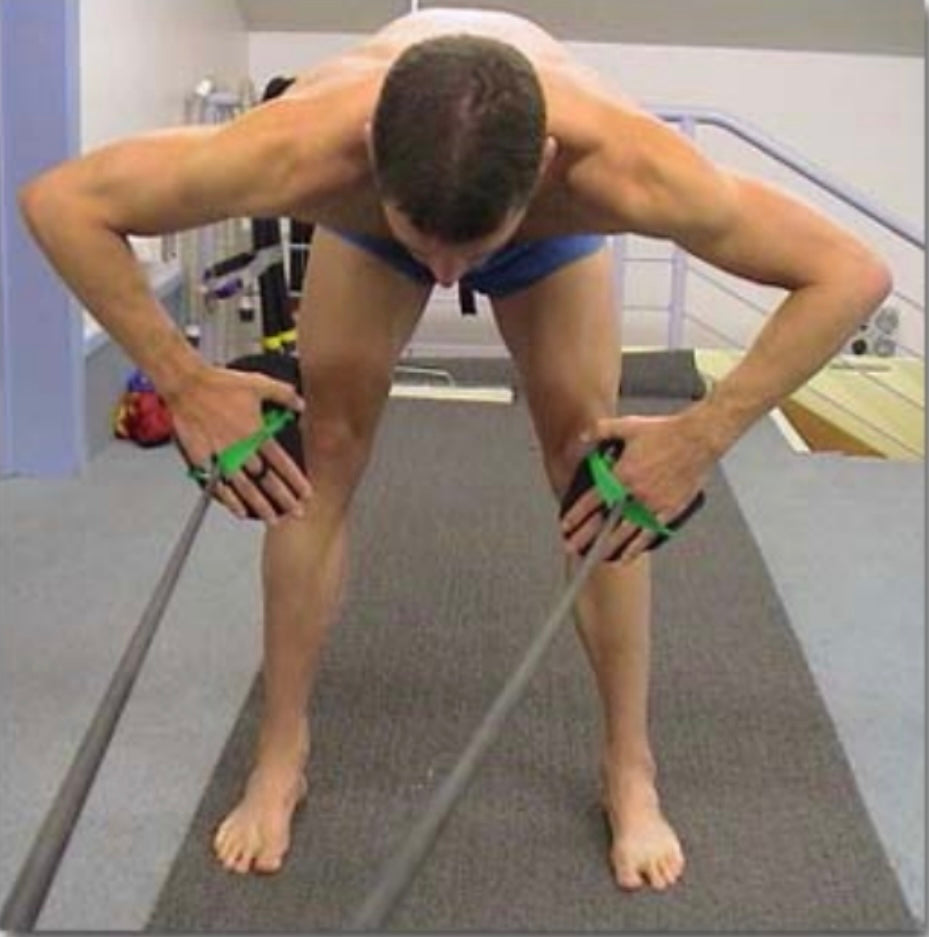
Step Two:
Ending Position -- very good.

#2 - Back-Half Pushes
Set cords up as for front pulls.
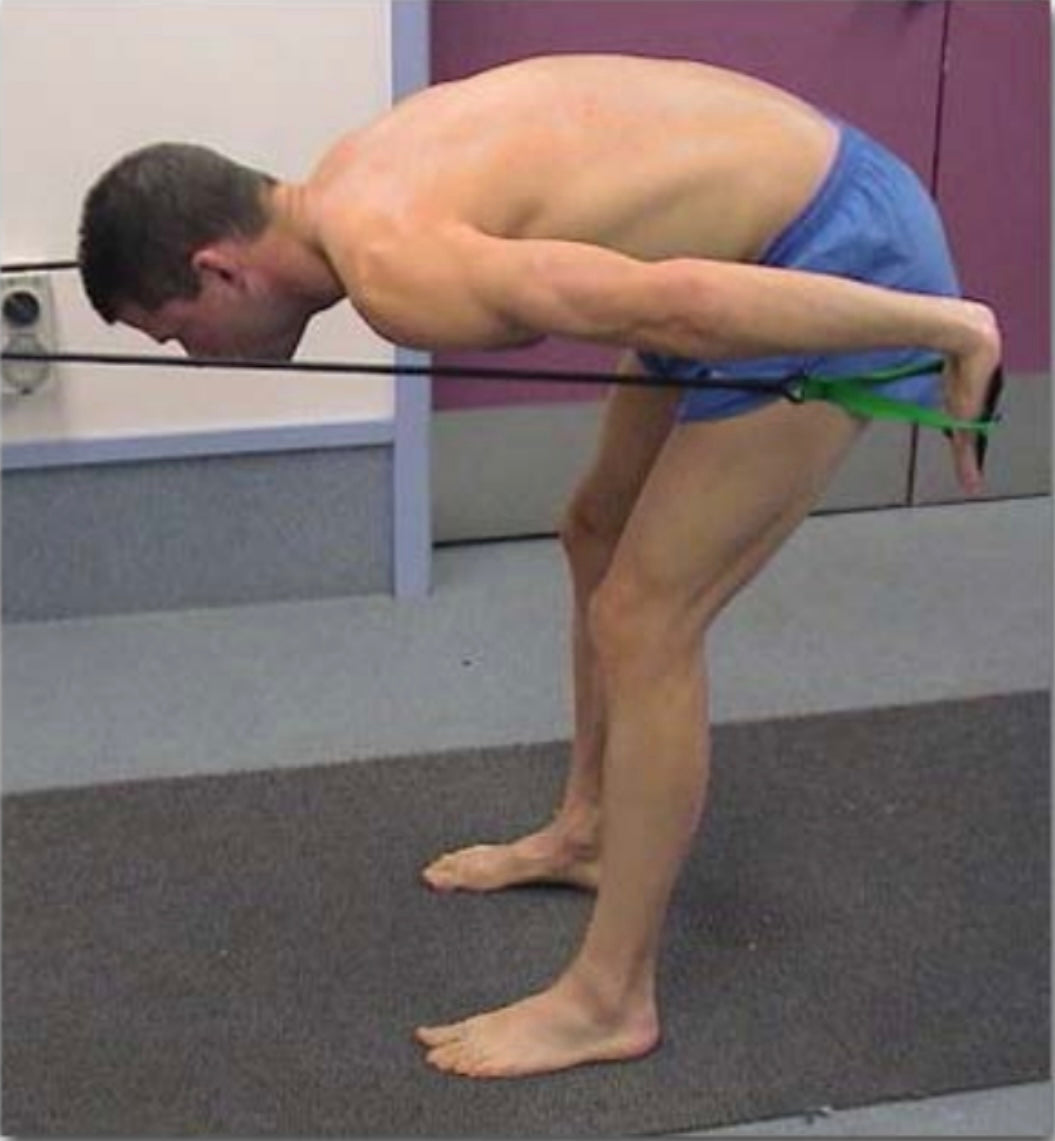
Step One:
Start at high elbow front half pull finish. Engage lats, and then triceps. Goal is to build very good back end strength.
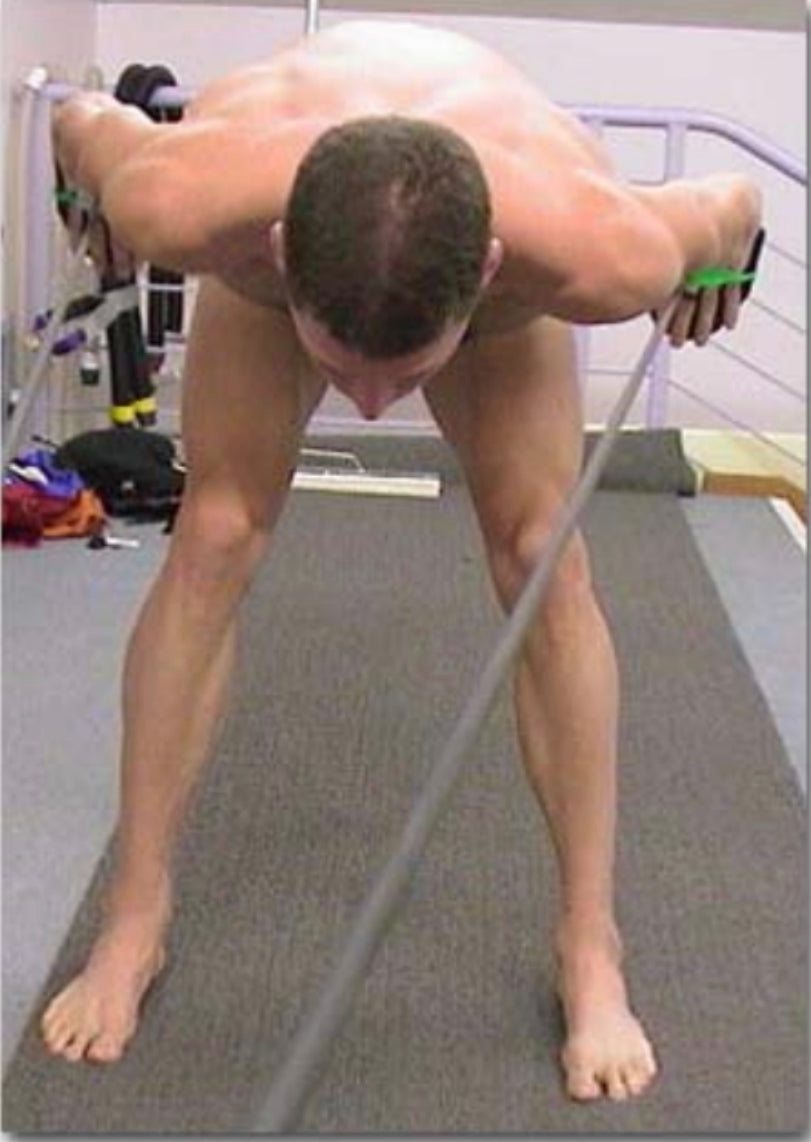
Step Two:
Careful observers of this progression will see that the hands are always pointing straight down. The palm is always pointing straight back.
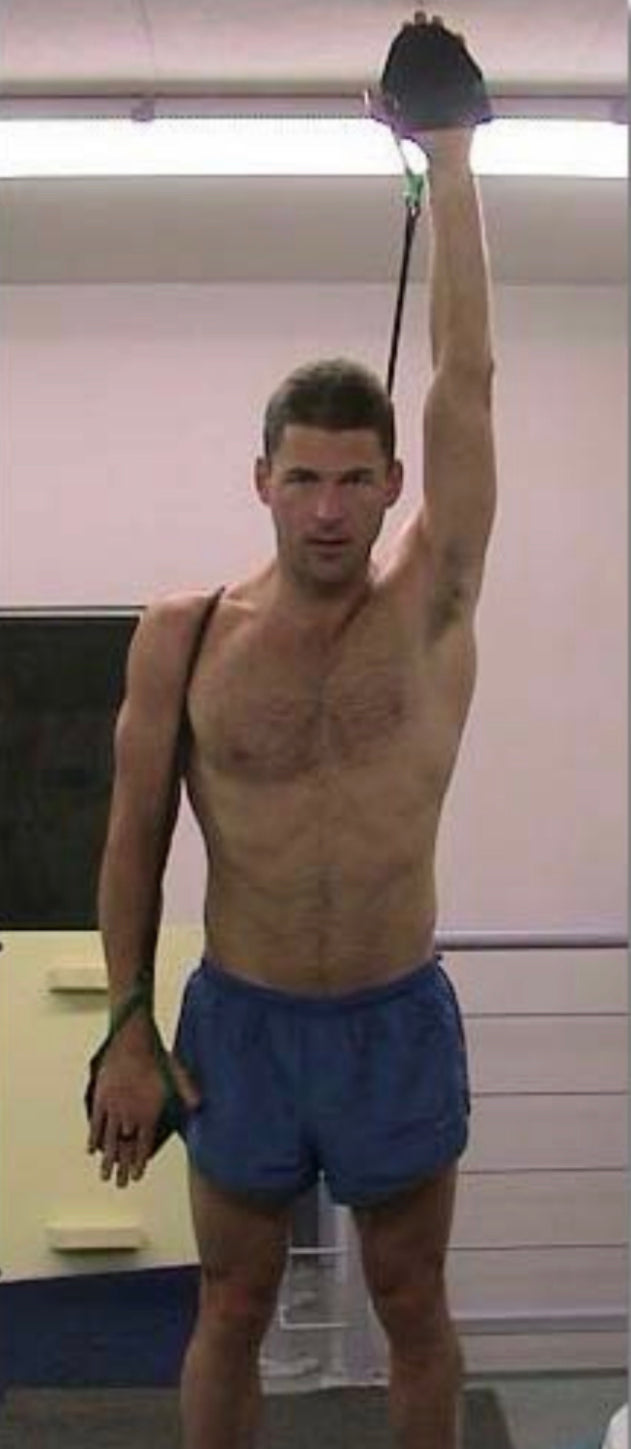
#3 - Standing Straight Arm
Face away, both arms straight with hands over head, alternate arms, arm moves in a semi-circle from 12 to 6 o'clock.
